语言学笔记第一章
胡壮麟语言学第1章笔记

[语言](什么是语言)●语言是人类用于交际的任意的声音符号系统●语言是言语交流的一种方式(简洁地说)●语言是人类最重要的交际工具、思维工具、认识成果的贮存所●语言是实用性的●语言是社会的、约定俗成的●语言是把人和其他动物区别开来的一个重要标志●语言有四个本质特征:任意性、二重性、创造性、移位性*实用性的——因为说和写的交流方式是一种有目的的行为*社会的、约定俗成的——因为语言的交流只能在所有参与者广泛理解了人类的那些非谚语的暗示、动机、社会文化角色等等互相关联的因素之后才能有效进行。
[语言的本质特征]*(Russell)“不管一只狗可以多么流利地吠叫,它无法告诉你它的父母贫穷但又诚实。
”本质特征是决定我们人类语言性质的特征,包括任意性、二重性、创造性、移位性。
1 [任意性]由Saussure最先提出●指语言符号的形式与意义之间没有自然的联系如果人类第一次看到猪是把它叫成“狗”,那么现在我们所知道的“猪”便叫做“狗”。
不同的语言中有不同的词来表达相同的概念:酒店—hotel,狗—dog同一语言中由于方言、历史、地理位置等原因也会出现这一特性:素质—质素,公鸡—鸡公,客人—人客●是人类语言多样性的一个重要原因●有不同的程度:(1)语素的音和义之间的任意性狗叫:wow wow—wang wang拟声词的发音看上去代表了他们所描述的词,但实际上任意性和拟声是可以同时起作用的(2)句法上的任意性对于系统功能语言学家和美国功能语言学家来说,语言在句法上是非任意的。
因为句子序列和真实发生的事情之间有着一定程度的对应关系He came in and sat down.He sat down and come in.功能语言学家认为语言最严格的任意性在于对立的语音,通过它我们辨别各组词。
(3)约定性语言学上意义和符号之间是约定俗成的关系,所以语言有约定性,即任意性的相反面任意性赋予语言潜在的创造力,约定性又使学习语言变得费力。
《语言学教程》中文笔记(完整)
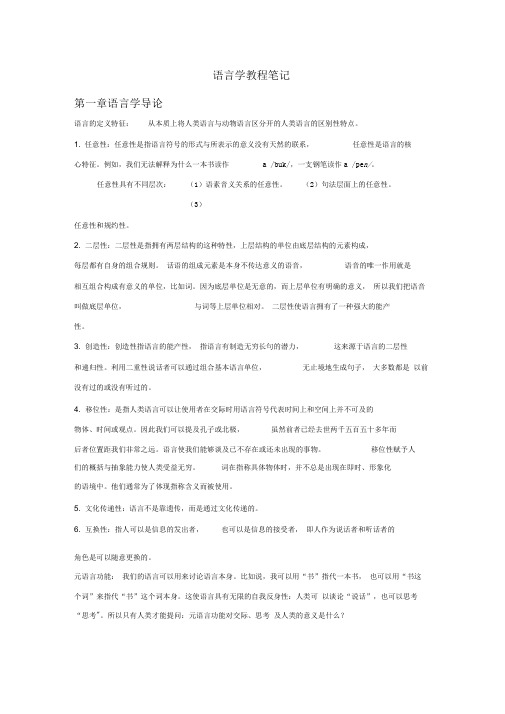
语言学教程笔记第一章语言学导论语言的定义特征:从本质上将人类语言与动物语言区分开的人类语言的区别性特点。
1. 任意性:任意性是指语言符号的形式与所表示的意义没有天然的联系,任意性是语言的核心特征。
例如,我们无法解释为什么一本书读作 a /buk/,一支钢笔读作a /pe n/。
任意性具有不同层次:(1)语素音义关系的任意性。
(2)句法层面上的任意性。
(3)任意性和规约性。
2. 二层性:二层性是指拥有两层结构的这种特性,上层结构的单位由底层结构的元素构成,每层都有自身的组合规则。
话语的组成元素是本身不传达意义的语音,语音的唯一作用就是相互组合构成有意义的单位,比如词。
因为底层单位是无意的,而上层单位有明确的意义,所以我们把语音叫做底层单位,与词等上层单位相对。
二层性使语言拥有了一种强大的能产性。
3. 创造性:创造性指语言的能产性,指语言有制造无穷长句的潜力,这来源于语言的二层性和递归性。
利用二重性说话者可以通过组合基本语言单位,无止境地生成句子,大多数都是以前没有过的或没有听过的。
4. 移位性:是指人类语言可以让使用者在交际时用语言符号代表时间上和空间上并不可及的物体、时间或观点。
因此我们可以提及孔子或北极,虽然前者已经去世两千五百五十多年而后者位置距我们非常之远。
语言使我们能够谈及已不存在或还未出现的事物。
移位性赋予人们的概括与抽象能力使人类受益无穷。
词在指称具体物体时,并不总是出现在即时、形象化的语境中。
他们通常为了体现指称含义而被使用。
5. 文化传递性:语言不是靠遗传,而是通过文化传递的。
6. 互换性:指人可以是信息的发出者,也可以是信息的接受者,即人作为说话者和听话者的角色是可以随意更换的。
元语言功能:我们的语言可以用来讨论语言本身。
比如说,我可以用“书”指代一本书,也可以用“书这个词”来指代“书”这个词本身。
这使语言具有无限的自我反身性:人类可以谈论“说话”,也可以思考“思考"。
英语语言学笔记1-何兆熊
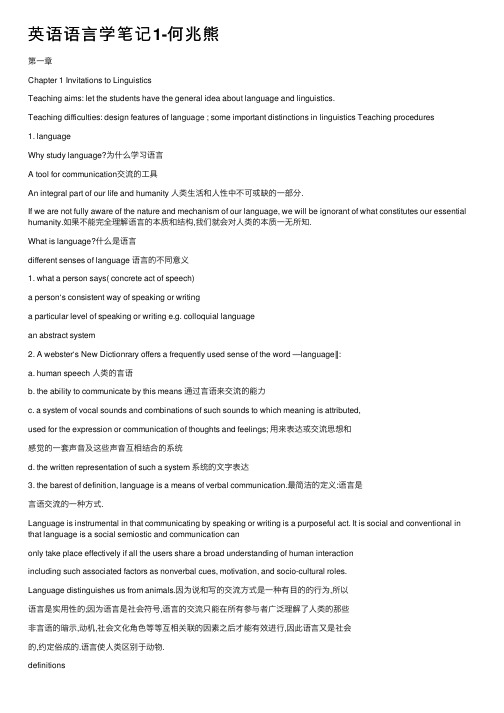
英语语⾔学笔记1-何兆熊第⼀章Chapter 1 Invitations to LinguisticsTeaching aims: let the students have the general idea about language and linguistics.Teaching difficulties: design features of language ; some important distinctions in linguistics Teaching procedures1. languageWhy study language?为什么学习语⾔A tool for communication交流的⼯具An integral part of our life and humanity ⼈类⽣活和⼈性中不可或缺的⼀部分.If we are not fully aware of the nature and mechanism of our language, we will be ignorant of what constitutes our essential humanity.如果不能完全理解语⾔的本质和结构,我们就会对⼈类的本质⼀⽆所知.What is language?什么是语⾔different senses of language 语⾔的不同意义1. what a person says( concrete act of speech)a person‘s consistent way of speaking or writinga particular level of speaking or writing e.g. colloquial languagean abstract system2. A webster‘s New Dictionrary offers a frequently used sense of the word ―language‖:a. human speech ⼈类的⾔语b. the ability to communicate by this means 通过⾔语来交流的能⼒c. a system of vocal sounds and combinations of such sounds to which meaning is attributed,used for the expression or communication of thoughts and feelings; ⽤来表达或交流思想和感觉的⼀套声⾳及这些声⾳互相结合的系统d. the written representation of such a system 系统的⽂字表达3. the barest of definition, language is a means of verbal communication.最简洁的定义:语⾔是⾔语交流的⼀种⽅式.Language is instrumental in that communicating by speaking or writing is a purposeful act. It is social and conventional in that language is a social semiostic and communication canonly take place effectively if all the users share a broad understanding of human interactionincluding such associated factors as nonverbal cues, motivation, and socio-cultural roles.Language distinguishes us from animals.因为说和写的交流⽅式是⼀种有⽬的的⾏为,所以语⾔是实⽤性的;因为语⾔是社会符号,语⾔的交流只能在所有参与者⼴泛理解了⼈类的那些⾮⾔语的暗⽰,动机,社会⽂化⾓⾊等等互相关联的因素之后才能有效进⾏,因此语⾔⼜是社会的,约定俗成的.语⾔使⼈类区别于动物.definitionsLanguage is a system of arbitrary vocal symbols used for human communication.What is communication?A process in which information is transmitted from a source (sender or speaker) to a goal (receiveror listener).A system----since elements in it are arranged according to certain rules systematically, rather thanrandomly. They cannot be arranged at will. e.g. He the table cleaned. (×) bkli (×) Why do we say language is arbitrary? Arbitrary----there is no intrinsic (logic) connection between a linguistic form and its meaning, between the sounds that people use and the objects to which these sounds refer. Thisexplains and is explained by the fact that different language have different words for thesame object, it is good illustration of the arbitrary nature of language . it is only our tacitagreement of utterance and concept at work and not any innate relationship bound upin the utterance. A typical example to illustrate the arbitrary of language is a famousquotation from shakepeare‘s play:‖ Romeo and Juliet: A rose by any other name wouldsmell as sweet.⼀朵玫瑰不管它叫什么名字,闻起来都是⼀样⾹的.Symbols----words are just the symbols associated with objects, actions, and ideas by nothing but convention. Namely, people use the sounds or voval forms to symbolize what they wishto refer to.Vocal-------- the primary medium for all languages is sound, no matter how well developed their writing systems are. Writing systems came much later than the spoken forms. The factthat small children learn and can only learn to speak and listen before they write or readalso indicates that language is primarily vocal, rather than written.Writing systems came into being much later than the spoken forms.People with little or no literacy can also be competent language users.Human ----language is human-specific.Human beings have different kinds of brains and vocal capacity.―Language Acquisition Device‖(LAD)⼆.What characteristics of langauge do you think should be included in a good ,comprenhensive definition of language? Language is a rule-governed system; langauge is basically vocal; langauge is arbitrary ; langague is used for human communication.1.3 Design features of language 语⾔的结构特征Design features------ refers to the defining properties of human language that distinguish it from any animal system of communication. They are arbitrariness, duality, creativity/ productivity, displacement, clutural transmission and interchangeability.Design features----- are features that define our human languages,such asarbitrariness,duality,creativity,displacement,cultural transmission,etc.(指决定了⼈类语⾔性质的特征.例如任意性,⼆重性,创造性,移位性,⽂化转移性等.)The American linguist Charles Hockett specified twelve design features.What is arbitrariness?任意性a. arbitrariness【'ɑ?b?tr?r?n?s】----arbitrariness(任意性): one design feature of humanlanguage,which refers to the fact that the forms of linguistic signs bear no naturalrelationship to their meaning.(⼈类语⾔的本质特征之⼀,指语⾔符号的形式与意义之间没有⾃然的联系.)It was discussed by Saussure first.The link between them is a matter of convention.E.g. ―house‖ uchi (Japanese)Mansion (French)房⼦(Chinese)(1) arbitrary between the sound of a morpheme and its meaning语⾔的⾳和义之间的任意性a. By ―arbitrary‖, we mean there is no logical connection between meanings and sounds. 语⾔的意义和语⾳之间没有逻辑关系。
语言学笔记大全

同样的意义内容,在不同的语言中有不同的语音形式,这是不同的社会习惯决定的,是不同的民族在创造这个词的时候选择了不同的语音形式,各个社会的成员约定俗成的,因为语音形式和意义的联系是任意的,非本质的,所以不同语言之间出现这样的差异就不奇怪了。
四、怎样理解语言符号的任意性和线条性特点?
任意性和线条性是语言符号的两个最基本的特点。语言符号的任意性是指语言符号的音义关系是由社会约定的,用什么样的“音”去表达什么样的“义”人们说不出什么道理,完全由社会约定,这种音义关系又叫约定性;语言符号的线条性是指符号的使用只能在时间的线条上绵延,一个符号跟着一个符号依次出现。如以“小王打碎了杯子”为例,每个字只能顺着时间的先后一个跟着一个说出来,绝不能在同一时点同时蹦出两个字来。依次出现的符号要遵守一定的规则,不能随意编排。这就是说,符号的线条性是由规则支配的,对社会成员具有强制性。如“我吃饭”不能说成“饭吃我”。但是,语言又是不断发展变化的,具有可变性特点。如一些新词的出现,一字词的新用法。这种变化,又从另一个方面说明了语言符号的任意性特点,也即语言符号的音义联系是社会约定的,而不是天然的、本质的联系。
4、用“棋、下、有、一、完、没、的、盘”这八个词组成句子,看能组合成多少句子?
这些词可以组合成下列句子:
一盘没有下完的棋、没有下完的一盘棋、没有一盘下完的棋、没下完的棋有一盘、下完的棋一盘没有、下完的棋没有一盘、有一盘没下完的棋、有没下完的一盘棋、棋没下完的有一盘、棋有一盘没下完……
5、语言实际上是一种社会现象,怎样理解这句话?
二、什么是语言符号?为什么说语言是一种符号系统?
语言学概论第一章语言与语言学笔记
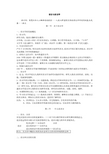
语言与语言学语言学:智慧而令人心醉神迷的探索--人类从野蛮到文明的进化中所使用的基本武器--语言。
第一节关于语言学一、语言学的发展概况1、语文学:研究目的:阅读古籍和语言教学。
古印度:公元前4世纪《巴尼尼语法》;古希腊:西方哲学的故乡;古中国:“小学”文字学《说文解字》、音韵学《广韵》、训诂学《尔雅》、第一部语法专著《马氏文通》。
2、历史比较语言学产生于19世纪初,用历史的方法和比较的方法研究语言,是语言学真正诞生的标志。
语言学从此摆脱了经学的附庸地位。
3、结构主义语言学,也叫普通语言学。
1916年费尔迪南·德·索绪尔《普通语言学教程》的出版标志着结构主义语言学的诞生。
这本著作是语言学史上的一个里程碑,影响极为深远。
索绪尔的语言学思想标志着人类语言学史的一个伟大的转折,索绪尔本人也被称为现代语言学之父。
4、转换生成语言学1957年,美国语言学家乔姆斯基的《句法结构》问世标志着转换生成语言学的诞生。
二、语言学1、定义:语言学是以人类所有语言作为研究对象的学科,研究人类语言的性质、结构、功能、发展演变规律。
2、语言学的分类标准:(1)功能角度:理论语言学和应用语言学;(2)具体研究对象:普通(一般)语言学/个别(专语、具体)语言学;(3)研究时段:共时语言学和历时语言学;(4)研究方法:描写语言学和对比语言学本课程的核心内容是讲授普通语言学的内容。
普通语言学是以全人类的语言为研究对象,研究语言的性质、功能、结构、规律。
3、本课程的特点是:(1)高度抽象;(2)涉及全球所有语言。
4、学习语言学的意义:(1)提高语言修养,使领悟、解释语言的能力增强。
(2)开拓自己的语言事业,增加自己的语言知识,更好的了解母语。
汉语: A、语音特点:①元音占优势;②无复辅音;③有音乐性的声调;B、语法:①汉语靠语序和虚词表达语法意义;②汉语有大量的量词;第二节什么是语言一、语言、言语首先区别语言和言语的是索绪尔。
语言学笔记第一章

I. INTRODUCTION1.1 What is linguistics?1.1.1DefinitionLinguistics is the scientific study of language. It studies not any particular language, but it studies languages in general.1.1.2 The scope of linguisticsGeneral linguistics: This deals with the basic concepts, theories, descriptions, models and methods applicable in any linguistic study, in contrast to those branches of study which relate linguistics to the research of other areas.Branches of linguistics:phonetics phonology morphology syntax semantics pragmatics Linguisticspsycholinguistics sociolinguistics applied linguistics1.1.3 Some important distinction in linguistics1) Prescriptive and descriptiveThey are two different types of linguistic study. If a linguistic study aims to describe and analyze the language people actually use, it is said to be descriptive; if the linguistic study aims to lay down rules for “ correct and standard” behavior in using language, i. e. to tell people what they should say and what they should not say, it is said to be prescriptive.Modern linguistics is mostly descriptive.2) Synchronic and diachronicLanguage exists in time and changes through time. The description of a language at some point of time in history is a synchronic study; the description of a language as it changes through time is a diachronic study. A diachronic study of language is historical study; it studies the historical development of language over a period of time.In modern linguistics, a synchronic approach seems to enjoy priority over a diachronic one.3) Speech and writingThey are the two major media of linguistic communication. Speech is prior to writingfor the following reasons:From the point of view of linguistic evolution, writing system os any language is always "invented" by its users to record speech when the need arises.Then in everyday communication, speech plays a greater role than writing in terms of the amount of information conveyedSpeech is always the way in which every native speaker acquires his mother tongue and writing is learned and taught later when he goes to school.4) Langue and paroleThe distinction between langue and parole was made by the Swiss linguist F. de Saussure in the early 20th century.Langue refers to the abstract linguistic system shared by all the members of a speech community, and parole refers to the realization of langue in actual use.Langue is the set of conventions and rules which language users all have to abide by, and parole is the concrete use of he conventions and the application of the rules. Langue is abstract; it is not the language people actually. Parole is concrete; it refers to the naturally occurring language events. Langue is relatively stable; it does not change frequently; while parole varies from person to person, and from situation to situation.5) Competence and performanceThe distinction between competence and performance was proposed by the American linguist N. Chomsky in the late 1950’s. Chomsky defines competence as the ideal user’s knowledge of the rules of his language, and performance the actual realization of this knowledge in linguistic communication.6) Traditional grammar and modern linguisticsThe beginning of modern linguistics was marked by the publication of F. de Saussure's book "Course in General Linguistics" in the early 20th century.a) Linguistics is descriptive, while traditional grammar is prescriptive.A linguistist is interested in what is said, not in what he thinks ought to be said. He describes language in all its aspects, but does not prescribe rules of "correctness".b) Modern linguistics regards the spoken language as primary, not the written. Traditional grammar tended to emphasize the importance of the written word.c) Modern linguistics does not force language into a Latin-based framework. However, for a long time traditional grammar assumed that Latin provides a universal framework into which all languages fit.1.2 What is language1.2.1 Definition of language?Language is a system of arbitrary vocal symbols used for human communication. First, language is a system, i.e., elements of language are combined according to rules.Second, language is arbitrary in the sense that there is no intrinsic connection between a linguistic symbol and what the symbol stands for.Third, language is vocal because the primary medium for all languages is sound.The term "human" in the definition is meant to specify that language is human-specific, i.e., it is very different from the communication systems other forms of life possess, such as bird songs and bee dances.2.2 Design featuresDesign features refer to the defining properties of human language that distinguish it from any animal system of communication. The framework was proposed by an American linguist, Charles Hockett.1) ArbitrarinessLanguage is arbitrary because there is no logical connection between meanings and sounds. However, we should be aware that while language is arbitrary by nature, it is not entire arbitrary; certain words are motivated.2) ProductivityLanguage is productive in that it makes possible the construction and interpretation of new signals by its users. This is the way they can produce and understand an indefinitely large number of sentences in our native languages, including sentences that we have never heard before.3) DualityLanguage is a system, which consists of two sets of structures, or two levels. At the lower or the basic level there is a structure of sounds, which are meaningless by themselves. But the sounds of language can be grouped and regrouped into a large number of units of meaning, which are found at the higher level of the system.Then the units at the higher level can be arranged and rearranged into an infinite number of sentences.4) DisplacementHuman language can be used to refer to things which are present or not present, real or imagined matters in the past, present, or future, or in far-away places. In other words, language can be used to refer to contexts removed from the immediate situations of the speaker.5) Cultural transmissionThe details of the linguistic system must be learned anew by each speaker. Though the capacity for language in human beings has a genetic basis, the particular language a human being learns is a cultural fact, not a genetic one.1.2.3 Functions of language1. Language is used for communication2. Three main functionsA)Descriptive function(cognitive, referential, or propositional function)--- it is assumed to be the primary function of language. It is the function to convey factual information, which can be asserted or denied, and in some cases even verified.B)Expressive function(emotive or attitudinal function) --- supplies information about the user's feelings, preferences, prejudices and values.C)Social function, also referred to as interpersonal function, serves to establish and maintain social relation between people.3.Function models by structural linguist Roman JakobsonHe identifies six elements of a speech event and relates each one of them to one specific language function.Addresser--- EmotiveThe addresser expresses his attitude to the topic or situation of communication. Addressee--- ConativeThe addresser aims to influence the addressee's course of action or ways of thinking. Context --- ReferentialThe addresser conveys a message or information.Message --- PoeticThe addresser uses language for the sole purpose of displaying the beauty of language itself.Contact --- Phatic communicationThe addresser tries to establish or maintain good interpersonal relationship with the addressee.Code --- MetalinguisticThe addresser uses language to make clear the meaning of language itself.4.Three macrofunctions by M. A. K. HallidayIn the early 1970s the British linguist Halliday found that child language performed seven basic functions and there is close correspondence language between form and function. But as a child grew into an adult the seven functions are gradually replaced by a more abstract, but also simpler system of functions. This system contains three macrofunctions.Ideational function is to organize the speaker or writer's experience of the real or imaginary world. It corresponds closely to the descriptive function discussed above, but it is broader because it also includes the expression of the speaker's attitude, evalution, his feelings and emotions.The interpersonal function is to indicate, establish, or maintain social relationships between people. It expresses the speaker's role in the speech situation, his personal commitment and assessment of the social relationship between the addressee and himself.The textual function is to organize written or spoken texts in such a manner that they are coherent within themselves and fit the particular situation in which they are used.。
语言学概论经典复习笔记(全)
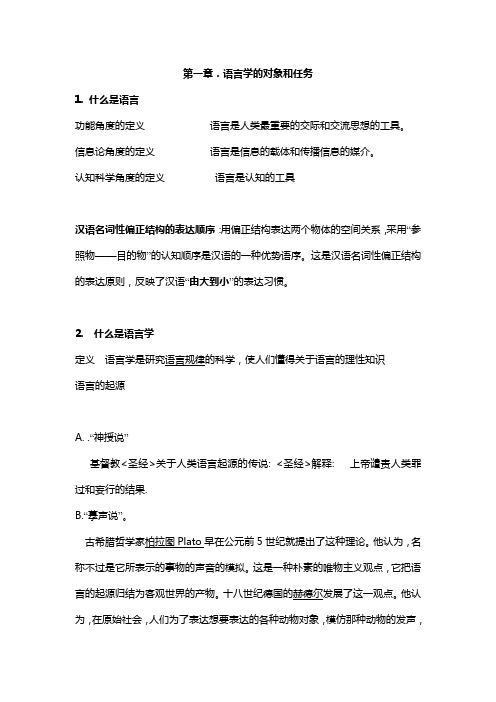
第一章.语言学的对象和任务1. 什么是语言功能角度的定义语言是人类最重要的交际和交流思想的工具。
信息论角度的定义语言是信息的载体和传播信息的媒介。
认知科学角度的定义语言是认知的工具汉语名词性偏正结构的表达顺序:用偏正结构表达两个物体的空间关系,采用“参照物——目的物”的认知顺序是汉语的一种优势语序。
这是汉语名词性偏正结构的表达原则,反映了汉语“由大到小”的表达习惯。
2. 什么是语言学定义语言学是研究语言规律的科学,使人们懂得关于语言的理性知识语言的起源A. .“神授说”基督教<圣经>关于人类语言起源的传说: <圣经>解释: 上帝谴责人类罪过和妄行的结果.B.“摹声说”。
古希腊哲学家柏拉图Plato早在公元前5世纪就提出了这种理论。
他认为,名称不过是它所表示的事物的声音的模拟。
这是一种朴素的唯物主义观点,它把语言的起源归结为客观世界的产物。
十八世纪德国的赫德尔发展了这一观点。
他认为,在原始社会,人们为了表达想要表达的各种动物对象,模仿那种动物的发声,比如拟声词。
C.“感叹说”。
古希腊哲学家伊壁鸠鲁(Epicurus, 公元前341~前270年)是其代表人物这种理论认为,原始人的感情冲动、受到惊恐后发出的喊叫等,也就是出于内心和外来的感受而发出的声音逐渐发展为感叹词,最终形成了语言。
D.“号子说”。
19世纪的法国哲学家努阿尔认为,原始人在集体劳动时会发出“咳哟”、“啊哈”等声音,以协调劳动的一致性,大致相当于今天的劳动号子,这就形成语言最初的成分——动词。
E.“劳动说”。
恩格斯首先提出来的。
恩格斯认为:一方面“劳动的发展必然促使社会成员更紧密地互相结合起来因为它使互相帮助和共同协作的场合增多了,并且使每个人都清楚地意识到这种共同协作的好处。
另一方面,劳动还使人的发音器官和大脑发达起来。
这些都是语言诞生的必要条件。
3语文学A 定义:为注解古代经典(如政治、哲学、历史、文学等经典作品),而对其中的文字\词汇\语法所作的研究.语文学是经学的附庸,没有把语言作为独立的学科研究. 又叫“前语言学”.印度宗教经典梵语:语音、语法研究西欧(希腊-罗马)古典拉丁文:语法、修辞、逻辑中国先秦典籍:汉字形音义研究三个重要的传统古印度巴尼尼<梵语语法>古希腊-罗马底奥尼修<希腊语法> 瓦罗《论拉丁语》中国“小学”中国第一部语法专著马建忠《马氏文通》(1898)采用的也是拉丁语的体系。
语言学第一章笔记和习题
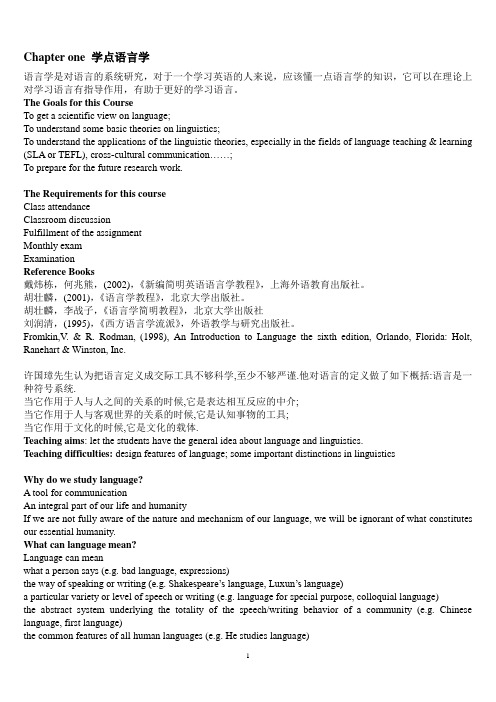
Chapter one 学点语言学语言学是对语言的系统研究,对于一个学习英语的人来说,应该懂一点语言学的知识,它可以在理论上对学习语言有指导作用,有助于更好的学习语言。
The Goals for this CourseTo get a scientific view on language;To understand some basic theories on linguistics;To understand the applications of the linguistic theories, especially in the fields of language teaching & learning (SLA or TEFL), cross-cultural communication……;To prepare for the future research work.The Requirements for this courseClass attendanceClassroom discussionFulfillment of the assignmentMonthly examExaminationReference Books戴炜栋,何兆熊,(2002),《新编简明英语语言学教程》,上海外语教育出版社。
胡壮麟,(2001),《语言学教程》,北京大学出版社。
胡壮麟,李战子,《语言学简明教程》,北京大学出版社刘润清,(1995),《西方语言学流派》,外语教学与研究出版社。
Fromkin,V. & R. Rodman, (1998), An Introduction to Language the sixth edition, Orlando, Florida: Holt, Ranehart & Winston, Inc.许国璋先生认为把语言定义成交际工具不够科学,至少不够严谨.他对语言的定义做了如下概括:语言是一种符号系统.当它作用于人与人之间的关系的时候,它是表达相互反应的中介;当它作用于人与客观世界的关系的时候,它是认知事物的工具;当它作用于文化的时候,它是文化的载体.Teaching aims: let the students have the general idea about language and linguistics.Teaching difficulties: design features of language; some important distinctions in linguisticsWhy do we study language?A tool for communicationAn integral part of our life and humanityIf we are not fully aware of the nature and mechanism of our language, we will be ignorant of what constitutes our essential humanity.What can language mean?Language can meanwhat a person says (e.g. bad language, expressions)the way of speaking or writing (e.g. Shakespeare‘s language, Luxun‘s language)a particular variety or level of speech or writing (e.g. language for special purpose, colloquial language)the abstract system underlying the totality of the speech/writing behavior of a community (e.g. Chinese language, first language)the common features of all human languages (e.g. He studies language)a tool for human communication. (social function)a set of rules. (rule-governed)The origins of language---the myth of languageThe Biblical accountLanguage was God‘s gift to human beings.The bow-wow theoryLanguage was an imitation of natural sounds, such as the cries of animals, like quack, cuckoo.The pooh-pooh theoryLanguage arose from instinctive emotional cries, expressive of pain or joy.The yo-he-ho theoryLanguage arose from the noises made by a group of people engaged in joint labour or effort – lifting a huge hunted game, moving a rock, etc.The evolution theoryLanguage originated in the process of labour and answered the call of social need.To sum up:The divine-origin theory: language is a gift of god to mankind.The invention theory: imitative, cries of nature, the grunts of men working together.The evolutionary theory: the result of physical and psychological development.What is LanguageLanguage is a system of arbitrary vocal symbols used for human communication.What is communication?A process in which information is transmitted from a source (sender or speaker) to a goal (receiver or listener).A system----elements in it are arranged according to certain rules. They cannot be arranged at will.e.g. He the table cleaned. (×) bkli (×)Arbitrary----there is no intrinsic (logic) connection between a linguistic form and its meaning.Symbols----words are just the symbols associated with objects, actions, and ideas by convention.V ocal--------the primary medium for all languages is sound, no matter how well developed their writing systems are.Writing systems came into being much later than the spoken forms.People with little or no literacy can also be competent language users.Human ----language is human-specific.Human beings have different kinds of brains and vocal capacity.―Language Acquisition Device‖(LAD)Design features of language 语言的结构特征Design features refers to the defining properties of human language that distinguish it from any animal system of communication.a. arbitrariness----the form of linguistic signs bear no natural relationship to their meaning. The link between them is a matter of convention.E.g. ―house‖ uchi (Japanese)Mansion (French)房子(Chinese)conventionality----It means that in any language there are certain sequences of sounds that have a conventionally accepted meaning. Those words are customarily used by all speakers with the same intendedmeaning and understood by all listeners in the same way.There are two different schools of belief concerning arbitrariness. Most people, especially structural linguists believe that language is arbitrary by nature. Other people, however, hold that language is iconic, that is, there is a direct relation or correspondence between sound and meaning, such as onomatopoeia.(cuckoo; crash)For the majority of animal signals, there does appear to be a clear connection between the conveyed message and the signal used to convey it, And for them, the sets of signals used in communication is finite.b. duality----language is simultaneously organized at two levels or layers, namely, the level of sounds and that of meaning.the higher level ----words which are meaningfulthe lower or the basic level----sounds which are meaningless, but can be grouped and regrouped into words. Dog: woof (but not ―w-oo-f ‖ )This duality of levels is, in fact, one of the most economical features of human language, since with a limited set of distinct sounds we are capable of producing a very large number of sound combinations (e.g. words) which are distinct in meaning.The principle of economyc. Productivity/Creativity----language is resourceful. It makes possible the construction and interpretation of new signals by its users.(novel utterances are continually being created.)non-human signals ,on the other hand, appears to have little flexibility.e.g. an experiment of bee communication:The worker bee, normally able to communicate the location of a nectar source , will fail to do so if the location is really ‗new‘. In one experiment, a hive of bees was placed at the foot of a radio tower and a food source at the top. Ten bees were taken to the top, shown the food source, and sent off to tell the rest of the hive about their find. The message was conveyed via a bee dance and the whole gang buzzed off to get the free food. They flow around in all directions, but couldn‘t locate the food. The problem may be that bee communication regarding location has a fixed set of signals, all of which related to horizontal distance. The bee cannot create a ‗new ‘ message indicating vertical distance.d. Displacement----human languages enable their users to symbolize objects, events and concepts which are not present at the moment of communication.Bee communication:When a worker bee finds a source of nectar and returns to the hive, it can perform a complex dance routine to communicate to the other bees the location of this nectar. Depending on the type of dance (round dance for nearby and tail-wagging dance, with variable tempo, for further away and how far), The other bees can work put where this newly discovered feast can be found. Bee communication has displacement in an extremely limited form. However, it must be the most recent food source.e. Cultural transmission----genetic transmissionYou acquire a language in a culture with other speakers and not from parental genes.The process whereby language is passed on from one generation to the next is described as cultural transmission.f. interchangeability: it means that individuals who use a language can both send and receive any permissible message within that communication system. Human beings can be a producer as well as receiver of messages.g. human vocal tractFunctions of language (3+6+7+3)1. Three main functionsthe descriptive function: the primary function of language. It is the function to convey factual information, which can be asserted or denied, and in some cases even verified.the expressive function: it supplies information about the user‘s feelings, preferences, prejudices and values. the social function:also referred to as the interpersonal function, serves to establish and maintain social relations between people2. The Russian-born structural linguists Roman Jakobson identifies six elements of a speech event and relates each one of them to one specific language function. That is, in conjunction of the six primary factors of any speech event, he established a well-known framework of language functions based on the six key elements of communication in his famous article: Linguistics and PoeticsAddresser—Emotive (intonation showing anger)Addressee—Conative (imperatives and vocatives)Context—Referential (conveys a message or information)Message—Poetic (indulge in language for its own sake)Contact—Phatic communion (to establish communion with others)Code—Metalinguistic (to clear up intentions, words and meanings)3. In the early 1970s the British linguist M.A.K. Halliday found that child language performed seven basic functions, namely, instrumental, regulatory, representational, interactional, personal, heuristic, and imaginative. This system contains three macrofunctions—the ideational, the interpersonal and the textual function.three meta-functions proposed by M. A. K. Halliday(1) The ideational functionTo identify things, to think, or to record information. It constructs a model of experience and constructs logical relations(2) The interpersonal functionTo get along in a community. It enacts social relationships(3) The textual functionTo form a text. It creates relevance to context.What is Linguistics(语言学)Linguistics is a scientific study of language .It is a major branch of social science.Linguistics studies not just one language of any society, but the language of all human society, language in general.A scientific study is one which is based on the systematic investigation of data, conducted with reference to some general theory of language structure.Process of linguistic study:① Certain linguistic facts are observed, generalization are formed;② Hypotheses are formulated;③ Hypotheses are tested by further observations;④ A linguistic theory is constructed.observation------generalization-----hypothesis------tested by further observation------theoryPerson who studies linguistics is known as a linguist.The Scope of LinguisticsGeneral linguistics is the study of language as a whole.Internal branches: intra-disciplinary divisions (micro-linguistics)Phonetics(语音学) is the branch of linguistics which studies the characteristics of speech sounds and provides methods for their description, classification and transcription.Phonology(音韵学) is the branch of linguistics which studies the sound patterns of languages.Morphology(词法) is the branch of linguistics which studies the form of words.Syntax(句法) is the branch of linguistics which studies the rules governing the combination of words into sentences.Semantics(语义学) is the branch of linguistics which studies the meaning of language.Pragmatics(语用学) is the branch of linguistics which studies the meaning of language in use.External branches: inter-disciplinary divisions (macro-linguistics)Applied linguistics(应用语言学) is the study of the teaching of foreign and second languages. Sociolinguistics is the study of the relationship between language and society.Psycholinguistics is the study of the relationship between language and the mind.Historical Linguistics(历史语言学) is the study of language changes.Anthropological linguistics(人文语言学) uses the theories and methods of anthropology to study language variation and language use in relation to the cultural patterns and beliefs of man.Neurolinguistics(神经语言学) studies the neurological basis of language development and use in human beings. Mathematical linguistics(数学语言学) studies the mathematical features of language, often employing models and concepts of mathematics.Computational linguistics(计算语言学) is an approach to linguistics in which mathematical techniques and concepts(概念) are applied, often with the aid of a computer.Features of linguisticsDescriptiveDealing with spoken languageSynchronicSome Basic Distinctions(区分) in Linguistics1. Speech and WritingOne general principle(原则) of linguistic analysis is the primacy of speech over writing. Writing gives language new scope(范畴) and uses that speech does not have.2. Descriptive(描述性) or Prescriptive(说明性)A linguistic study is descriptive if it describes and analyses facts observed; it is prescriptive if it tries to lay down rules for "correct" behavior.3. Synchronic(共时) and Diachronic(历时) StudiesThe description of a language at some point in time is a synchronic study and The description of a language as it changes through time is a diachronic study.4. Langue(语言) and Parole(言语)This is a distinction made by the Swiss linguist F.De Saussure (索绪尔)early last century. langue refers to the abstract linguistic system shared by all the members of a speech community and parole refers to the actualized(实际的) language, or realization of langue.5. Competence(能力)and Performance(行为)Competence is the ideal language user's knowledge of the rules of his language. Performance is the actualrealization of this knowledge in utterances(发声).6. Potential and Behavior: English linguist Halliday makes another similar distinction in the 1960s, namely the distinction between linguistic potential and linguistic behavior. He approaches language from a functional view and concentrates primarily on what speakers do with language which led to the distinction between linguistic potential (what speakers can do with language) and behavior (what speakers actually do with language). In Halliday‘s distinction between potential and behavior, potential is similar to Saussure‘s ―langue‖and Chomsky‘s competence, and behavior is similar to Saussure‘s ―parole‖ and Chomsky‘s performance.7. Modern linguistics started with the public ation of F. de Saussure‘ s book ―Course in General Linguistics‖ in the early 20th century. So Saussure is often described as ―father of modern linguistics‖.The general approach traditionally formed to the study of language before that is roughly referred to as ―traditional grammar.‖ They differ in several basic ways:Firstly, linguistics is descriptive while traditional grammar is prescriptive. A linguist is interested in what is said, not in what he thinks ought to be said. He describes language in all its aspects, but does not prescribe rules of ―correctness‖.Secondly, modern linguistics regards the spoken language as primary, not the written. Traditional grammarians, on the other hand, tend to emphasize, may be over-emphasize, the importance of the written word, partly because of its permanence.Then, modern linguistics differs from traditional grammar also in that it does not force languages into a Latin-based framework. To modern linguists ,it is unthinkable to judge one language by standards of another. They are trying to set up a universal framework, but that would be based on the features shared by most of the languages used by mankind.Chapter I IntroductionI. Decide whether each of the following statements is True or False:1. Linguistics is generally defined as the scientific study of language.2.Linguistics studies particular language, not languages in general.3. A scientific study of language is based on what the linguist thinks.4. In the study of linguistics, hypotheses formed should be based on language facts and checked against the observed facts.5. General linguistics is generally the study of language as a whole.6. General linguistics, which relates itself to the research of other areas, studies the basic concepts, theories, descriptions, models and methods applicable in any linguistic study.7. Phonetics is different from phonology in that the latter studies the combinations of the sounds to convey meaning in communication.8. Morphology studies how words can be formed to produce meaningful sentences.9. The study of the ways in which morphemes can be combined to form words is called morphology.10. Syntax is different from morphology in that the former not only studies the morphemes, but also the combination of morphemes into words and words into sentences.11. The study of meaning in language is known as semantics.12. Both semantics and pragmatics study meanings.13. Pragmatics is different from semantics in that pragmatics studies meaning not in isolation, but in context.14.Social changes can often bring about language changes.15. Sociolinguistics is the study of language in relation to society.16. Modern linguistics is mostly prescriptive, but sometimes descriptive.17. Modern linguistics is different from traditional grammar.18. A diachronic study of language is the description of language at some point in time.19 Modern linguistics regards the written language as primary, not the written language.20. The distinction between competence and performance was proposed by F. de Saussure.II. Fill in each of the following blanks with one word which begins with the letter given:21. Chomsky defines ― competence‖ as the ideal user's k__________ of the rules of his language.ngue refers to the a__________ linguistic system shared by all the members of a speech community while the parole is the concrete use of the conventions and application of the rules.23.D_________ is one of the design features of human language which refers to the phenomenon that language consists of two levels: a lower level of meaningless individual sounds and a higher level of meaningful units.nguage is a system of a_________ vocal symbols used for human communication.25. The discipline that studies the rules governing the formation of words into permissible sentences in languages is called s________.26. Human capacity for language has a g ____ basis, but the details of language have to be taught and learned.27. P ____ refers to the realization of langue in actual use.28. Findings in linguistic studies can often be applied to the settlement of some practical problems. The study of such applications is generally known as a________ linguistics.nguage is p___________ in that it makes possible the construction and interpretation of new signals by its users. In other words, they can produce and understand an infinitely large number of sentences which they have never heard before.30. Linguistics is generally defined as the s ____ study of language.III. There are four choices following each statement. Mark the choice that can best complete the statement.31. If a linguistic study describes and analyzes the language people actually use, it is said to be ______________.A. prescriptiveB. analyticC. descriptiveD. linguistic32.Which of the following is not a design feature of human language?A. ArbitrarinessB. DisplacementC. DualityD. Meaningfulness33. Modern linguistics regards the written language as ____________.A. primaryB. correctC. secondaryD. stable34. In modern linguistics, speech is regarded as more basic than writing, because ___________.A. in linguistic evolution, speech is prior to writingB. speech plays a greater role than writing in terms of the amount of information conveyed.C. speech is always the way in which every native speaker acquires his mother tongueD. All of the above35. A historical study of language is a ____ study of language.A. synchronicB. diachronicC. prescriptiveD. comparative36.Saussure took a (n)__________ view of language, while Chomsky looks at language from a ________ point of view.A. sociological…psychologicalB. psych ological…sociologicalC. applied… pragmaticD.semantic and linguistic37. According to F. de Saussure, ____ refers to the abstract linguistic system shared by all the members of a speech community.A. paroleB. performanceC. langueD. Language38. Language is said to be arbitrary because there is no logical connection between _________ and meanings.A. senseB. soundsC. objectsD. ideas39. Language can be used to refer to contexts removed from the immediate situations of the speaker. This feature is called_________,A. displacementB. dualityC. flexibilityD. cultural transmission40. The details of any language system is passed on from one generation to the next through ____ , rather than by instinct.A. learningB. teachingC. booksD. both A and B。
语言学纲要笔记第一章

第一章语言的功能语言的功能是多方面的,从宽泛的意义讲,大致都可以归入语言的社会功能和思维功能两方面。
第一节:语言的社会功能语言的社会功能:信息传递功能和人际互动功能。
一、语言的信息传递功能:信息传递功能是最基本的社会功能。
这一功能体现在语言上就是内容的表达。
各种信息传递形式的比较:身势等非语言的形式,独自传递的信息有限,多半是辅助语言来传递信息;文字是建立在语言基础之上的再编码形式;旗语之类则是在语言或文字基础之上的再编码形式;语言是人类社会信息传递第一性的、最基本的手段。
二、语言的人际互动功能建立或保持某种社会关联,即是语言的人际互动功能。
可以这样理解:说话者在传递客观经验信息的同时,在也表达主观的情感、态度和意图,寻求听话者的反馈。
而受话者在接收说话者传递的客观信息的同时,也了解了说话者的主观情感态度,从而做出回应。
说话者———————————————————————————→受话者(寻求反馈)传递客观经验信息;表达主观情感、态度和意图(做出回应)第二节:语言的思维功能一、语言和思维的关系语言是社会现象,是社会的交际工具,同时也是心理现象,是人类思维的工具。
思维功能是语言功能的另一个重要方面。
二、语言思维功能的生理基础大脑是语言思维功能的生理基础,语言功能区主要存在于左半球。
(左半球掌管抽象、概括的思维,右半球掌管不需要语言的感性直观思维)(不过,人脑分工是存在的,但其运用是综合性的)。
三、儿童语言习得和思维的发展1.独词句→双词句(孩子学话中的关键的两步)从某类概念→不同事物的区别和不同事物中共同的东西,同时把统一的事物分析成不同的要素。
独词句体现了词与事物的联系,特别是词指称整类事物的概括性。
双词句体现了造句的基本原理,就是选择需要的词,按照学会的格式把它们组合在一起。
2.大体发展趋势:独词句→双词句→实词句→虚词的掌握→熟练运用语言也就是外界的现象概念范畴化的过程。
3.儿童语言习得的条件:儿童语言习得一定得具有先天生理基础,其中最重要的就是大脑的结构和功能。
语言学概论笔记(邢福义)
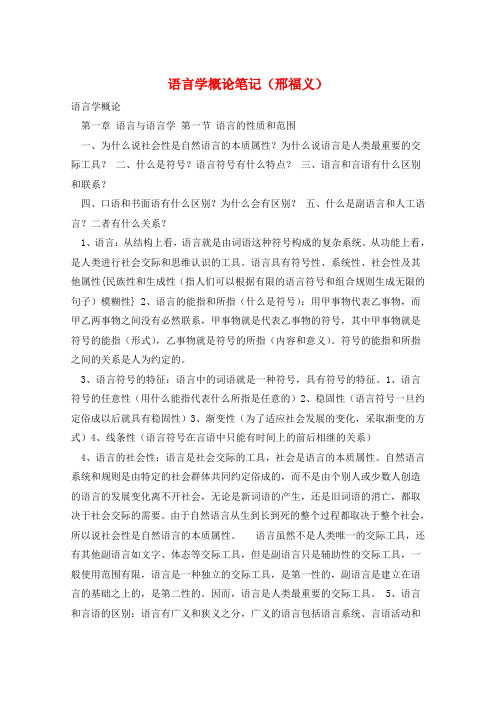
语言学概论笔记(邢福义)语言学概论第一章语言与语言学第一节语言的性质和范围一、为什么说社会性是自然语言的本质属性?为什么说语言是人类最重要的交际工具?二、什么是符号?语言符号有什么特点?三、语言和言语有什么区别和联系?四、口语和书面语有什么区别?为什么会有区别?五、什么是副语言和人工语言?二者有什么关系?1、语言:从结构上看,语言就是由词语这种符号构成的复杂系统。
从功能上看,是人类进行社会交际和思维认识的工具。
语言具有符号性、系统性、社会性及其他属性{民族性和生成性(指人们可以根据有限的语言符号和组合规则生成无限的句子)模糊性}2、语言的能指和所指(什么是符号):用甲事物代表乙事物,而甲乙两事物之间没有必然联系,甲事物就是代表乙事物的符号,其中甲事物就是符号的能指(形式),乙事物就是符号的所指(内容和意义)。
符号的能指和所指之间的关系是人为约定的。
3、语言符号的特征:语言中的词语就是一种符号,具有符号的特征。
1、语言符号的任意性(用什么能指代表什么所指是任意的)2、稳固性(语言符号一旦约定俗成以后就具有稳固性)3、渐变性(为了适应社会发展的变化,采取渐变的方式)4、线条性(语言符号在言语中只能有时间上的前后相继的关系)4、语言的社会性:语言是社会交际的工具,社会是语言的本质属性。
自然语言系统和规则是由特定的社会群体共同约定俗成的,而不是由个别人或少数人创造的语言的发展变化离不开社会,无论是新词语的产生,还是旧词语的消亡,都取决于社会交际的需要。
由于自然语言从生到长到死的整个过程都取决于整个社会,所以说社会性是自然语言的本质属性。
语言虽然不是人类唯一的交际工具,还有其他副语言如文字、体态等交际工具,但是副语言只是辅助性的交际工具,一般使用范围有限,语言是一种独立的交际工具,是第一性的,副语言是建立在语言的基础之上的,是第二性的。
因而,语言是人类最重要的交际工具。
5、语言和言语的区别:语言有广义和狭义之分,广义的语言包括语言系统、言语活动和言语作品,狭义的语言只指语言系统,而言语则包括言语活动和言语作品。
语言学概论笔记(第一章)

语言学概论笔记第一章:语言和语言学一、识记内容。
1、口语:语言的客观存在形式首先是有声的口头语言。
2、书面语:文字出现以后,语言的第二种客观存在形式。
3、符号:指的是根据社会的约定俗成使用某种特定的物质实体来表示某种特定的意义而形成的这种实体和意义的结合体。
4、能指:语言符号的物质实体能够指称某种意义的成分。
5、所指:也就是“能指成分”,即特定的物质实体,所指的意义内容。
6、聚合关系:在同一个位置上可以互相替换出现的各个语言单位处在互相可以联想起来的关系之中,因而聚合成为一个类。
7、组合关系:组合关系体现为一个语言单位和前一个语言单位或后一个语言单位,或和前后两个语言单位之间的关系,也体现了部分与整体之间的关系。
8、语言学:是研究语言的科学。
9、普通语言学:语言学界把研究人类社会的语言这种社会现象的一般理论。
10、理论语言学:把研究某种具体语言的语言学称为汉语语言学或英语语言学等等,把侧重理论探讨的称为理论语言学。
11、应用语言学:把侧重语言学理论和成果的实际应用。
12、传统语言学:一般泛指20世纪以前的语言学,特别是指索绪尔开创的结构主义语言学以前的语言学。
13、结构主义语言学:索绪尔创立的语言学可以称为“结构主义语言学”,至于我国内常说的“结构主义语言学”、“结构主义语法”,往往只是指在国外影响较大并且我国语言学界比较熟悉的美国结构主义描写语言学,那只是当代结构主义语言学的一个流派,并不等于受索绪尔影响的整个结构主义语言学。
二、领会内容(不用识记,大体知道即可)1、言语交际是一个编码和解码的过程。
答:人要说话所需要的因素:生活经历、社会环境、当前处理的问题、社会问题、文化问题、哲学问题、逻辑问题。
人要接受语言所需要的因素:组织与分析的能力、心理、生理问题;发音、听音的器官和神经网络及机制和能力;复杂的生理和物理问题。
总之一句话,言语交际是通过许多因素对语言进行编码和解码的过程,言者编码,听者解码。
语言学笔记1

Chapter one Introduction一、定义1.语言学LinguisticsLinguistics is generally defined as the scientific study of language.2.普通语言学General LinguisticsThe study of language as a whole is often called General linguistics.3.语言languageLanguage is a system of arbitrary vocal symbols used for human communication.语言是人类用来交际的任意性的有声符号体系。
4.识别特征Design FeaturesIt refers to the defining poperties of human language that distinguish it from any animal system of communication.语言识别特征是指人类语言区别与其他任何动物的交际体系的限定性特征。
Arbitrariness任意性Productivity多产性Duality双重性Displacement移位性Cultural transmission文化传递⑴arbitrarinessThere is no logical connection between meanings and sounds.P.S the arbitrary nature of language is a sign of sophistication and it makes it possible for language to have an unlimited source of expressions⑵ProductivityAnimals are quite limited in the messages they are able to send.⑶DualityLanguage is a system, which consists of two sets of structures ,or two levels.⑷DisplacementLanguage can be used to refer to contexts removed from the immediate situations of the speaker.⑸Cultural transmissionHuman capacity for language has a genetic basis, but we have to be taught and learned the details of any language system. this showed that language is culturally transmitted. not by instinct. animals are born with the capacity to produce the set of calls peculiar to their species.5.语言能力CompetenceCompetence is the ideal user‟s knowledge of the rules of his language.6.语言运用performancePerformance is the actual realization of this knowledge in linguistic communication.语言运用是所掌握的规则在语言交际中的体现。
语言学纲要笔记

语言学纲要笔记第一章 语言的功能一、语言是什么?1、语言是音义结合的符号系统,人类最重要的交际工具和思维工具。
2、a 人类的语言b 通过言语交际的能力c 一套语音系统以及产生意义的语音组合系统,用来表达交际思想和感受d 上述系统的书面表述社会功能语言是人类的社会的交际工具。
每个社会,无论是经济发达的社会还是经济十分落后的社会,都必须有自己的语言,都离不开语言这个交际工具,是不可少的一个因素。
人类与动物相区别的重要特征之一。
七大功能:信息功能——语言的主导功能人际功能——语言最重要的社会功能施为功能——可以执行某种行为 Eg: The bag is so heavy. 岁岁平安 感情功能——语言最有用的功能之一Eg:改变听者的态度;誓言;承受压力时摆脱紧张寒暄功能——语言的交互性娱乐功能——用处单一而有限 对歌、诗歌元语言功能 ——用自身研究自身(语言)第二章 语言是符号系统一、什么是符号?它有哪些因素构成?符号是一个社会全体成员共同约定用来表示某种意义的记号、标志。
语言符号: 形式:语音 风(能指)意义:气体的流动(所指)语言的核心特征——任意性语言符号任意性的作用二、层次性音位语言的层级体系,其音位层和符号层我们合称为语言的二层性底层无意义,上层有意义三、系统性组合关系:符号和符号相互结合起来的关系聚合关系:指在某一环节上具有相同作用的能够互相替换的符号间的关系四、递归性相同的规则可以再一个结构里重复使用五、文化的传递性人类的语言是由我们所接触的文化来传递的六、移位性使用音位交际时使用语言符号代表时间、空间上异不可及的物体、观点等。
第三章 语音一、什么是语音?什么是音节?什么是音系?1、语音是语言的物质材料,是人类的发音器官发出的代表一定意义的声音2、音节是音位和音位组合起来构成的最小的语音结构单位。
它是听觉上感受到的最自然底层语素 词 句子的单位。
比如我们说“我上课”很自然地辨别出这是由wo shang ke 这三个音节构成的3、音素是从音质角度划分出来的最小语音单位,音节往下切分,就是音素,比如音节wo 可以切分出w和o,一个音素只有一个发音动作,发音动作改变了,发音器官改变了,就发出了不同的音素。
语言学纲要笔记 第一章:语言学概论语言学纲要笔记 第一章:语言学概论
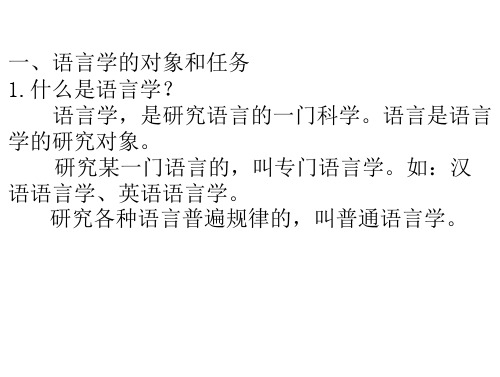
hunters歧义。
转换的意思是:一个长句子可以转换成各种短句子 例如:无形的上帝创造了有形的世界。这句话是 有三个核心句子构成:
上帝创造了世界 上帝是无形的 世界是有形的
转换语法可以分解the shooting of the hunters的 义。因为它可以转换为: 1 they shoot the hunters。 2 the hunters shoot a tiger。
• 数理语言学:用代数、计算机科学、统计学等领 域中的概念和方法研究语言的数学属性等问题。
• 计算语言学:用计算机科学的技术和概念研究语 言,特别是研究语言的理解和处理、机器翻译、 情报检索等问题
• 实验语音学:用各种实验仪器分析语音,研究语 音的识别和合成等问题。
第一章 语言的社会功能 第一节 语言是人类最重要的交际工具
一部解释词义的书,是中国古代的词典。
• 扬雄《方言》 、刘熙《释名》 • ——小学:文字、音韵、训诂
印度的语言研究
古代印度人研究语言主要是为了保存口头相传的婆罗 门教义《吠陀经》的原文和梵语文学,使之不致因时间的 流逝而面目全非。例:波尼尼(潘尼尼、巴尼尼 Pānini) 《八书》。
古印度语言学最突出的成就表现在语音学上。例如:
雅科布逊(1896年— 1982年) (区别特征学 说)《语音分析初探》(1951)
马德修斯(1882年—1945年)
该学派于1926年创建。其研究重点是:把语言 作为一种功能体系来进行研究和分析。特别重视音
• 哥本哈根学派 • 成立时间:1931 • 代表人物:叶尔姆斯列夫 • 代表作:《结构语言学》(布龙达尔1931)《语言理论
导论》(叶尔姆斯列夫 1953)、 《语符学纲要》(乌尔达尔 1957)、
语言学笔记
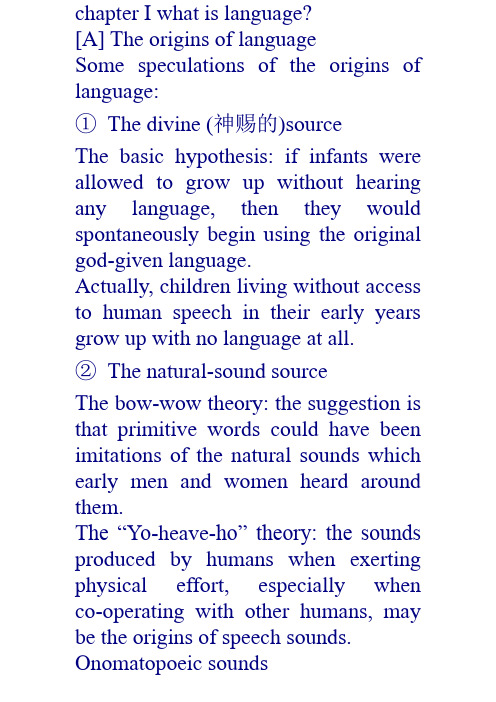
chapter I what is language?[A] The origins of languageSome speculations of the origins of language:①The divine (神赐的)sourceThe basic hypothesis: if infants were allowed to grow up without hearing any language, then they would spontaneously begin using the original god-given language.Actually, children living without access to human speech in their early years grow up with no language at all.②The natural-sound sourceThe bow-wow theory: the suggestion is that primitive words could have been imitations of the natural sounds which early men and women heard around them.The ―Yo-heave-ho‖ theory: the sounds produced by humans when exerting physical effort, especially when co-operating with other humans, may be the origins of speech sounds. Onomatopoeic sounds③The oral-gesture sourceIt is claimed that originally a set of physical gestures was developed as a means of communication.The patterns of movement in articulation(清晰发音)would be the same as gestural movement; hence waving tongue would develop from waving hand.④Glossogenetics (言语遗传学)This focuses mainly on the biological basis of the formation and development of human language.Physiological adaptationàdevelop naming abilityàinteractions and transactionsPhysical adaptation:Human teeth are upright and roughly even in height.Human lips have intricate(复杂的)muscle interlacing(交织), thus making them very flexible.The human mouth is small and contains a very flexible tongue.The human larynx(喉)is lowered, creating a longer cavity(腔)called the pharynx(咽), and making it easier for the human to choke on the pieces of food, but making the sound speech possible.The human brain is lateralized(边音的). Those analytic(善分析的)functions (tool-using and language) are largely confined to the left hemisphere of the brain for most humans.Two major functions of language: Interactional: a social function of language.Transactional: a function involving the communication of knowledge and informationThe properties of language Language is a system of arbitrary vocal symbols used for human communication.a) System: combined together according to rulesb) Arbitrary: no intrinsic connectionbetween the word ―pen‖ and the thing in the world which it refers toc) V ocal: the primary medium is sound for all languagesd) Human: language is human-specific (交际性与信息性) Communicative vs. Informative: Communicative: intentionally using language to communicate something Informative: through/via a number of signals that are not intentionally sent Design features (unique properties): the defining properties of human language that distinguish it from any animal system of communication①Displacement (跨时空性,移位性) Language can be used to refer to contexts removed from the immediate situations of the speaker (refer to past and future time and to other locations) ②Arbitrariness (任意性)There is no logical or natural connection between a linguistic form (either sound or word) and its meaning. While language is arbitrary by nature, itis not entirely arbitrary.a) echo of the sounds of objects or activities: onomatopoeic wordsb) some compound words③Productivity (能产性,创造性) Language is productive in that it makes possible the construction and interpretation of new signals by its users. (Creativity or open-endedness) ④Cultural transition (文化传递性) While human capacity for language has a genetic basis (everyone was born with the ability to acquire a language), the details of any language system are not genetically transmitted, but instead have to be taught and learnt.⑤Discreteness (可分离性)Each sound in the language is treated as discrete.⑥Duality (双重结构性,两重性或二元性)Language is organized at two levels or layers simultaneously. The lower orbasic level is a structure of sounds which are meaningless. The higher level is morpheme or word (double articulation)The above six properties may be taken as the core features of human language. V ocal-auditory channel, reciprocity(相互性), specialization, non-directionality, or rapid fade, these properties are best treated as ways of describing human language, but not as a means of distinguishing it from other systems of communication.[C] The development of written language①pictograms & ideograms (象形文字和表意文字)Pictogram: when some of the pictures came to represent particular images in a consistent way, we can begin to describe the product as a form of picture-writing, or pictograms. Ideogram: the picture developed as more abstract and used other than itsentity is considered to be part of a system of idea-writing, or ideogram Hieroglyph: 古埃及象形文字②Logograms (语标书写法)When symbols come to be used to represent words in a language, they are described as examples of word-writing, or logograms.“Arbitrariness‖—a writing system which was word-based had come into existence.Cuneiform--楔形文字—the Sumerians (5000 and 6000 years ago)Chinese is one example of its modern writing system.Advantages: two different dialects can be based on the same writing system. Disadvantages: vast number of different written forms.③Syllabic writing (音节书写法) When a writing system employs a set of symbols which represent the pronunciations of syllables, it is described as syllabic writing.The Phoenicians: the first human beings that applied the full use of a syllabic writing system (ca 1000 BC) ④Alphabetic writing (字母书写法) Semitic languages (Arabic and Hebrew): first applied this ruleThe Greeks: taking the inherently syllabic system from the Phoenicians via the RomansLatin alphabet and Cyrillic alphabet (Slavic languages)⑤Rebus writing(迷画书写)Robus writing evolves a process whereby the symbol used for an entity comes to be used for the sound of the spoken word used for that entity. Chapter II what is linguistics?[A] The definition of linguistics Linguistics is generally defined as the scientific study of language.Process of linguistic study:①Certain linguistic facts are observed, generalization are formed;②Hypotheses are formulated;③Hypotheses are tested by further observations;④A linguistic theory is constructed. Language is a system of arbitrary vocal symbols used for human communication.The scope of linguisticsGeneral linguistics: the study of language as a wholePhonetics(语音学): the general study of the characteristics of speech sounds (or the study of the phonic medium of language) (How speech sounds are produced and classified)Phonology(音系学): is essentially the description of the systems and patterns of speech sounds in a language. (How sounds form systems and function to convey meaning)Morphology(词态学): the study of the way in which morphemes(词素)are arranged to form words (howmorphemes are combined to form words)Syntax(句法): the study of those rules that govern the combination of words to form permissible sentences (how morphemes and words are combined to form sentences)Semantics(语义学): the study of meaning in abstractionPragmatics(语用学): the study of meaning in context of use Sociolinguistics: the study of language with reference to society Psycholinguistics(语言心理学): the study of language with reference to the workings of the mindApplied linguistics: the application of linguistics principles and theories to language teaching and learning Anthropological(人类学的)linguistics, neurological(神经学的)linguistics; mathematical linguistics; computational linguistics[C] Some important distinctions in linguistics①Prescriptive (规范性)vs. Descriptive②Synchronic(同步的)vs. Diachronic (历经长时间的)The description of a language at some point in time;The description of a language as it changes through time.③Speech and writingSpoken language is primary, not the written④Langue and parole语言和言语Proposed by Swiss linguists F. de Sausse (sociological)Langue: refers to the abstract linguistic system shared by all the members of a speech communityParole: refers to the realization of langue in actual use⑤Competence and performance Proposed by the American linguist N.Chomsky (psychological) Competence: the ideal user’s knowledge of the rules of his language Chapter III Phonetics and phonology [A] The definition of phonetics Phonetics: the study of the phonic medium of language: it is concerned with all the sounds that occur in the world’s languages.Articulatory phonetics: the study of how speech sounds are made, or articulated.Acoustic phonetics: deals with the physical properties of speech as sound waves in the air.Auditory (or perceptual) phonetics: deals with the perception, via the ear, of speech sounds.Forensic(辩论的/适于法庭的)phonetics: has an application in legal cases involving speaker identificationand the analysis of recorded utterances. Organs of speechV oiceless: when the vocal cords(声带)are spread apart, the air from the lungs passes between them unimpeded.V oiced: when the vocal cords are drawn together, the air from the lungs repeated pushes them apart as it passes through, creating a vibration effect.All the English vowels are typically voiced (voicing).The important cavities:The pharyngeal cavityThe oral cavityThe nasal cavityLips, teeth, teeth ridge (alveolus), hard palate, soft palate (velum), uvula, tip of tongue, blade of tongue, back of tongue, vocal cords[C] Orthographic representation of speech soundsBroad and narrow transcriptions宽式和严式音标IPA (International Phonetic Alphabet/Association)Broad transcription: the transcription with letter-symbols onlyNarrow transcription: the transcription with diacritics(附加符号)E.g.:[l]à[li:f]--à a clear [l] (no diacritic) [l]à[bild]--àa dark [l] (~)[l]à[helW]--àa dental [l] ()[p]à[pit]--àan aspirated [ph](h)[p]à[spit]--àan unaspirated [p] (no diacritic)[n]à[5bQtn]àa syllabic nasal [n] (7) [D] Classification of English consonants(辅音)In terms of manner of articulation (the manner in which obstruction(阻碍)is created)①Stops: the obstruction is total or complete, and then going abruptly [p]/, [t]/[d], [k]/[g]②Fricatives(摩擦音): the obstruction is partial, and the air is forced through a narrow passage in the month[f]/[v], [s]/[z], [W]/[T], [F]/[V], [h](approximant)③Affricates(破擦音): the obstruction, complete at first, is released slowly as in fricatives[tF]/[dV]④Liquids(流音): the airflow is obstructed but is allowed to escape through the passage between part or parts of the tongue and the roof of the mouth[l]àa lateral sound; [r]à retroflex⑤Glides(滑音): [w], [j] (semi-vowels)Liquid + glides + [h]à approximants⑥Nasals(鼻音): the nasal passage is opened by lowering the soft palate(上颚)to let air pass through it [m], [n], [N]By place of articulation (the place where obstruction is created)①bilabials双唇音: upper and lower lips are brought together to create obstructions[p]/, [w]à(velar)②labiodentals唇齿音: the lower lip and the upper teeth[f]/[v]③dentals齿音: the tip of the tongue and the upper front teeth[W]/[T]④alveolar齿槽音: the front part of the tongue on the alveolar ridge[t]/[d], [s]/[z], [n], [l], [r]⑤alveo-palatals (palato-alveolars): tongue and the very front of the palate, near the alveolar ridge[F]/[V], [tF]/[dV]⑥palatal上颚音: tongue in the middle of the palate[j]⑦velars软腭音: the back of the tongue against the velum[k], [g], [N] … [w]⑧glottals声门音: the glottal is the space between the vocal cords in the larynx[h][E] Classification of English vowels (元音)Front i: Central BackClose i ` u:uSemi-close e E: Semi-open E C:Open AB Q RB:①The highest position of the tongue: front, central, back;②The openness of the mouth: close, semi-close, semi-open, open;③the roundness (shape) of the month (the lips):All the front, central vowels are unrounded vowels exceptAll the back vowels, except [a:] are rounded vowels④The length of the sound: longvowels & short vowelsLarynx à (tense) or (lax) Monophthongs单元音, diphthongs双元音Cardinal(基本的)vowels[F] The definition of phonology Phonetics is interested in all the speech sounds used in all human languages; how they are produced, how they differ from each other, what phonetic features they possess, how they can be classified, etc.Phonology, on the other hand, is interested in the system of sounds of a particular languages; it aims to discover how speech sounds in a language form patterns and how these sounds are used to convey meaning in linguistic communication.[G] Phone语音, phoneme音素音位, and allophone音位变体Phone: the different versions of the abstract unit – phonemePhoneme: the mean-distinguishingsound in a language, placed in slash marksAllophone: a set of phones, all of which are versions of one phoneme [G] Phonemic contrast, complementary distribution, and minimal pair Phonemic contrast: when two phonemes can occur in the same environments in two words and they distinguish meaning, they’re in phonemic contrast.E.g. pin & bin à /p/ vs. /b/ rope & robe à /p/ vs. /b/Complementary distribution: two or more than two allophones of the same phonemes are said to be in complementary distribution because they can not appear at the same time, or occur in different environment, besides they do not distinguish meaning. Minimal pair: when two different forms are identical in every way except for one sound segment which occurs in the same place in the strings, the two sounds are said to form a minimal pair. When a group of words can bedifferentiated, each one from the others, by changing one phoneme (always in the same position), then all of these words constitute a minimal sets.[H] Some rules in phonology①sequential rulesSyllable音节表Onset开始rimeNucleus 核心coda结尾[Consonant] vowel [consonant(s)]Phonotactics(音位结构学)of 3Cs occurring in onset:No1:___/s/___voiceless stops: /p/, /t/, /k/___approximants: /r/, /l/, /w/, /j/No2:The affricates [tF]/[dV] and the sibilants [s], [z], [F], [V] are not to be followed by another sibilants.②assimilation rulesCo-articulation effects: the process of making one sound almost at the same time as the next is called co-articulation.Assimilation(同化)& elision(元音省略)effectsAssimilation: two phonemes occur in sequence and some aspect of one phoneme is taken or copied by the otherE.g. nasalize a vowel when it is followed by a nasal sound.③deletion(缺失)rule-Elision Definition: the omission(省略)of a sound segment which would be present in deliberate pronunciation of a word in isolationE.g. delete a [g] when it occurs before a final nasal consonant Suprasegmental(超切分音位)features①StressWord stress & sentence stressThe stress of the English compounds always on the first element②Tone音调Definition: Tones are pitch(音高)variations, which are caused by the differing rates of vibration of the vocal cords.Pitch variations can distinguish meaning just like morphemes.Tone language, like Chinese, has four tones.Level, rise, fall-rise, fall③Intonation语调When pitch, stress and sound length are tied to the sentence rather than the word in isolation, they are collectively known as intonation.English: the four basic types of intonation, or the four tonesThe falling tone, the rising tone, the fall-rising tone, and the rise-fall toneChapter IV Morphology词态学[A] The definition of morphology Morphology is a branch of grammar which studies the internal structure of words and the rules by which words are formed.Inflectional morphology曲折形态学Derivational morphology 派生形态学(lexical morphology词汇形态学) Morpheme: the smallest meaningful components of words(A minimal unit of meaning or grammatical function)Free morphemes自由语素& bound morphemes粘着语素Free morphemes: can stand by themselves as single wordsàLexical morphemes实意语素[n.a.v]& functional morphemes功能语素[conj.prep.art.pron.]Bound morphemes: can not normally stand alone, but which are typically attached to another formàDerivational morphemes派生语素----àaffix (suffix, infix, prefix) + rootàInflectional morphemes 曲折语素à88 types of inflectional morphemes in EnglishNoun+ -’s, -s [possessive; plural]V erb+ -s, -ing, -ed, -en [3rd person present singular; present participle; past tense, past participle]Adj+ -er, -est [comparative; superlative][C] Derivational vs. inflectional Inflectional morphemes never change the grammatical category of a word Inflectional morphemes influence the whole category;Derivational morphemes are oppositeOrder: root (stem) + derivational + inflectional[D] Morphological Rules形态学规则N. +lyàa.; A. +lyàadv.; guard overgeneralization[E] Morphs and allomorphs语素和语素变体Morphs: the actual forms used to realize morphemes词素Allomorphs: a set of morphs, all of which are versions of one morpheme, we refer to them as allomorphs of that morpheme.[F] Word-formation process①Coinageàthe invention of totally new terms②Borrowingàthe taking over of words form other languagesLoan-translation (Claque)à a direct translation of the elements of a word into the borrowing languageStand alone to be the opposite ofword-formation③Compoundingà a joining of two separate words to produce a single formFeatures of compoundsa) Orthographically, a compound can be written as one word, with or without a hyphen in between, or as two separate words.b) Syntactically, the part of speech of the compound is generally determined by the part of speech of the second element.c) Semantically, the meaning of a compound is often idiomatic, not always being the sum total of the meanings of its components.d) Phonetically, the stress of a compound always falls on the first element,While the second element receives secondary stress.④Blendingà混合taking over the beginning of one word and joining it to the end of other word⑤Clippingà a word of more than one syllable reduced to a shorter form⑥Back formationà a process by which new words are formed by taking away the suffix of an existing word Hypocorismsàclipping or +ie⑦Conversionàcategory change, functional shift⑧Acronymsà首字母缩写new words are formed from the initial letters of a set of other words⑨Derivationàthe new words are formed by the addition of affixes to the roots, stems, or words⑩Abbreviationà a shortened form of a word or phrase which represents the complete formAnalogyChapter V Grammar[A] Types of grammarThe study of grammar, or the study ofthe structure of expressions in a language, has a very long tradition.①Mental grammar: a form of internal linguistic knowledge which operates in the production and recognition of appropriately structured expressions in that language. àPsychologist②Linguistic etiquette规矩: the identification of the proper or best structures to be used in a language. àSociologist③The study and analysis of the structures found in a language, with the aim of establishing a description of the grammar of English, e.g. as distinct from the grammar of Russiaor French. à LinguistThe parts of speechNouns, adjectives, verbs, adverbs副词,prepositions介词, pronouns代词,conjunctions连词àthe grammatical categories of wordsin sentences[C] Traditional grammar (Categories and analysis)Other categories: number, person, tense, voice语态(主动被动)and gender Agreement:English languageßnatural gender Grammatical genderà French[D] Types of grammar concerning analysisThe prescriptive规范的approach: The view of grammar as a set of rules for the proper use of a languageThe descriptive approach: analysts collect samples of the language they are interested in and attempt to describe the regular structures of the language at it is used, not according to some view of how it should be used.[E] Structural and immediate constituent(直接成分)analysis (IC Analysis)Structural analysis: to investigate the distinction of forms (e.g. morphemes) in a languageIC Analysis: how small constituents (Components) in sentences go together to form larger constituents[F] Labeled and bracketed sentences Hierarchical organization of the constituents in a sentenceLabel each constituent with grammatical terms such as Art. N. NPChapter VI Syntax句法[A] The definition of syntaxA subfield(分区)of linguistics that studies the sentence structure of languageThe basic components of a sentence SentenceSubject`Predicate谓语Referring expression comprises finite verb or a verb phrase and says something about the subject [C] Types of sentencesSimple sentence: consists of a singleclause子句which contains a subject and a predicate and stands alone as its own sentence.Coordinate (Compound) sentence: contains two clauses joined by a linking word called coordinating conjunctions, such as ―and‖, ―by‖, ―or‖…Complex sentence: contains two, or more, clauses, one of which is incorporated into the other Embedded clauseßàmatrix clause①subordinator从属结构②functionsas a grammatical unit ③may be complete[D] The linear and hierarchical structures of sentencesWhen a sentence is uttered or written down, the words of the sentence are produced one after another in a sequence, which suggests the structure of a sentence is linear.But the superficial arrangement of words in a linear sequence does notentail that sentences are simply linearly-structured; sentences are organized with words of the same syntactic category, such as NP or VP, grouped together.Tree diagram of constituent structure Brackets and subscript labels括号和脚注标签[E] Some categoriesSyntactic categories: refer to a word or a phrase that performs a particular grammatical function, such as the subject or the predicateLexical categories词汇范畴: (parts of speech)Major lexical categories (open categories):N. V. Adj. Adv.Minor lexical categories (closed categories):Det. Aux. Prep. Pron. Conj. Int. Phrasal categories: NP, VP, PP, AP [F] Grammatical RelationsThe structural and logical functional relations of constituentsIt concerns the way each noun phrase in the sentence relates to the verb Subject of and direct object宾语of Structural subject, structural object Logical subject (the doer of the action), the logical object (the recipient of the action)These two groups of subjects and objects may have different positions [G] Combinational rulesAre small in number Yield all the possible sentencesRule out the impossible ones①phrase structure rules (rewrite rules)改写律Sà NP VP(A sentence consists of, or is rewritten as, a noun phrase and a verb phrase) NPà (Det.) (Adj.) N (PP) (S)An optional determiner….and obligatory noun,VPà V (NP) (POP) (S)APà A (PP) (S)PPà P NP②the recursiveness循环性of phrasestructure rulesSignificantly, the above rules can generate an infinite number of sentences, and sentences with infinite length, due to their recursive properties.③X- bar theoryHead an obligatory word that givers the phrase its nameXP or X-phraseXPà (Specifier) X (complement) Formula:X‖à Spec X’X-bar theory (X-bar schema)X’à X complTree diagramX‖Specifier X’Xcomplement[H] Syntactic movement and movement rulesSyntactic movement: occurs when a constituent in a sentence moves out of its original place to a new place Transformational rules转换原则①NP-movement and WH-movement NP-movement: active voice àpassive voicePostposing, preposingWH-movement: affirmativeàinterrogativeLeftward matter to the sentence initial-position②Other types of movementAux-movement: the movement of an auxiliary助动词to the sentence-initial position③D-structure and S-structureTwo levels of syntactic representation of a sentence structure:One that exists before movement takes placeThe other that occurs after movement takes placeFormal linguistic exploration:D-structure: phrase structure rules + lexiconSentence at the level of D-structure The application of syntactic movement rules transforms a sentence fromD-structure level to S-structure level Transformational-generative line of analysis④Move α– a general movement ruleMove any constituent to any place Certain constituents can move to only certain positionsUniversal Grammar (UG)Principles-and-parameters theory:原则与参数理论UG is a system of linguistic knowledge and a human species-specific gift which exits in the mind or brain of a normal human being and which consists of some general principles and parameters about natural languages.①general principles of UGCase condition principle: a noun phrasemust have case and case is assigned by V or P to the object position or by Aux to the subject positionAdjacency condition邻接条件or Case assignment: a case assignor and a case recipient should stay adjacency to each other.It is strictly observed in English well-formed sentences, not other languages (no other phrasal category can intervene between a verb and its direct object)The Adjacency condition must be subject to parametric variation in order to explain the apparent adjacency violations such as in French.②The parameters of UG Parameters are syntactic options of UG that allow general principles to operate in one way or another and contribute to significant linguistic variations between and among natural languages.[+strict adjacency]Adjacency parameter[-strict adjacency][Rightward directionality]The Directionality Parameter àinvolves word order[Leftward directionality]En: VP word order VPà V NP Jp: VP word order VPà NP V Natural languages are viewed to vary according to parameters set on UG principles to particular values. Chapter VII Semantics[A] The definition of semantics Definition: the study of meaning from the linguistic point of viewSome views concerning the study of meaning①the naming theory: The linguistic forms or symbols, in other words, the words used in a language are taken to be labels of the objects they stand for; words are just names or labels for things.②the conceptualist view概念观:There’s no direct link between a linguistic form and what it refers to (i.e. between language and the real world); rather, in the interpretation of meaning, they are linked through the mediation of concepts in the mind.Thought/reference conceptSymbol/Form (words) Referent à(real object)Proposed by Ogden & Richards③contextualism语境主义: John Firth The situational context: in a particular spatiotemporal situationLinguistic context (co-text): the probability of a word’s co-occurrence or collocation with another word④behaviorism àBloomfield based on contextualist viewBehaviorists define meaning of alanguage form as the situation in which the speaker utters it and the response it calls forth in the hearerS: stimulus r: responseJill JackS---------r………s---------R(the small letters r,sàspeech)(the capitalized letter R,Sàpractical events) [C] Sense and referenceSense: is concerned with the inherent meaning of the linguistic form, abstract and de-contextualized.Reference: means what a linguistic form refers to in the real, physical world; it deals with the relationship between the linguistic element and the non-linguistic world of experience Moving star I once was bitten by a dog.Morning star Mind you. There is a dog over there.[D] Major sense relations语义关系①synonymy同义the sameness or close similarity of meaninga. dialectal。
语言学笔记重点
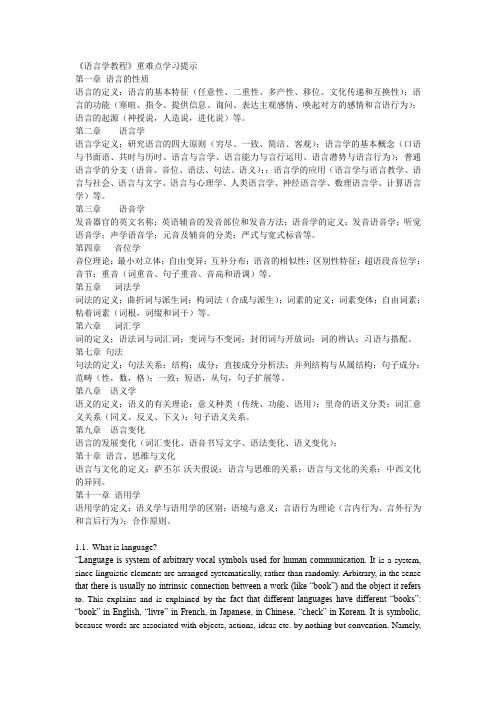
《语言学教程》重难点学习提示第一章语言的性质语言的定义:语言的基本特征(任意性、二重性、多产性、移位、文化传递和互换性);语言的功能(寒暄、指令、提供信息、询问、表达主观感情、唤起对方的感情和言语行为);语言的起源(神授说,人造说,进化说)等。
第二章语言学语言学定义;研究语言的四大原则(穷尽、一致、简洁、客观);语言学的基本概念(口语与书面语、共时与历时、语言与言学、语言能力与言行运用、语言潜势与语言行为);普通语言学的分支(语音、音位、语法、句法、语义);;语言学的应用(语言学与语言教学、语言与社会、语言与文字、语言与心理学、人类语言学、神经语言学、数理语言学、计算语言学)等。
第三章语音学发音器官的英文名称;英语辅音的发音部位和发音方法;语音学的定义;发音语音学;听觉语音学;声学语音学;元音及辅音的分类;严式与宽式标音等。
第四章音位学音位理论;最小对立体;自由变异;互补分布;语音的相似性;区别性特征;超语段音位学;音节;重音(词重音、句子重音、音高和语调)等。
第五章词法学词法的定义;曲折词与派生词;构词法(合成与派生);词素的定义;词素变体;自由词素;粘着词素(词根,词缀和词干)等。
第六章词汇学词的定义;语法词与词汇词;变词与不变词;封闭词与开放词;词的辨认;习语与搭配。
第七章句法句法的定义;句法关系;结构;成分;直接成分分析法;并列结构与从属结构;句子成分;范畴(性,数,格);一致;短语,从句,句子扩展等。
第八章语义学语义的定义;语义的有关理论;意义种类(传统、功能、语用);里奇的语义分类;词汇意义关系(同义、反义、下义);句子语义关系。
第九章语言变化语言的发展变化(词汇变化、语音书写文字、语法变化、语义变化);第十章语言、思维与文化语言与文化的定义;萨丕尔-沃夫假说;语言与思维的关系;语言与文化的关系;中西文化的异同。
第十一章语用学语用学的定义;语义学与语用学的区别;语境与意义;言语行为理论(言内行为、言外行为和言后行为);合作原则。
《语言学教程》中文笔记(完整)
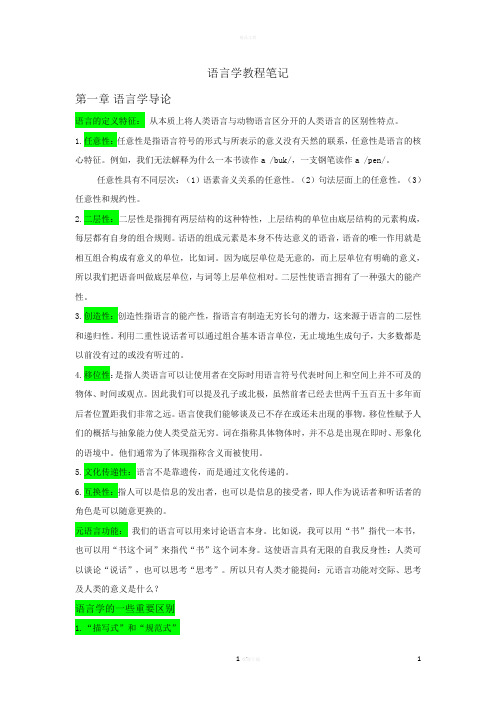
语言学教程笔记第一章语言学导论语言的定义特征:从本质上将人类语言与动物语言区分开的人类语言的区别性特点。
1.任意性:任意性是指语言符号的形式与所表示的意义没有天然的联系,任意性是语言的核心特征。
例如,我们无法解释为什么一本书读作a /buk/,一支钢笔读作a /pen/。
任意性具有不同层次:(1)语素音义关系的任意性。
(2)句法层面上的任意性。
(3)任意性和规约性。
2.二层性:二层性是指拥有两层结构的这种特性,上层结构的单位由底层结构的元素构成,每层都有自身的组合规则。
话语的组成元素是本身不传达意义的语音,语音的唯一作用就是相互组合构成有意义的单位,比如词。
因为底层单位是无意的,而上层单位有明确的意义,所以我们把语音叫做底层单位,与词等上层单位相对。
二层性使语言拥有了一种强大的能产性。
3.创造性:创造性指语言的能产性,指语言有制造无穷长句的潜力,这来源于语言的二层性和递归性。
利用二重性说话者可以通过组合基本语言单位,无止境地生成句子,大多数都是以前没有过的或没有听过的。
4.移位性:是指人类语言可以让使用者在交际时用语言符号代表时间上和空间上并不可及的物体、时间或观点。
因此我们可以提及孔子或北极,虽然前者已经去世两千五百五十多年而后者位置距我们非常之远。
语言使我们能够谈及已不存在或还未出现的事物。
移位性赋予人们的概括与抽象能力使人类受益无穷。
词在指称具体物体时,并不总是出现在即时、形象化的语境中。
他们通常为了体现指称含义而被使用。
5.文化传递性:语言不是靠遗传,而是通过文化传递的。
6.互换性:指人可以是信息的发出者,也可以是信息的接受者,即人作为说话者和听话者的角色是可以随意更换的。
元语言功能:我们的语言可以用来讨论语言本身。
比如说,我可以用“书”指代一本书,也可以用“书这个词”来指代“书”这个词本身。
这使语言具有无限的自我反身性:人类可以谈论“说话”,也可以思考“思考”。
所以只有人类才能提问:元语言功能对交际、思考及人类的意义是什么?语言学的一些重要区别1.“描写式”和“规范式”描写式:客观系统地记录一种语言的模式和用法或变化。
语言学概论读书笔记
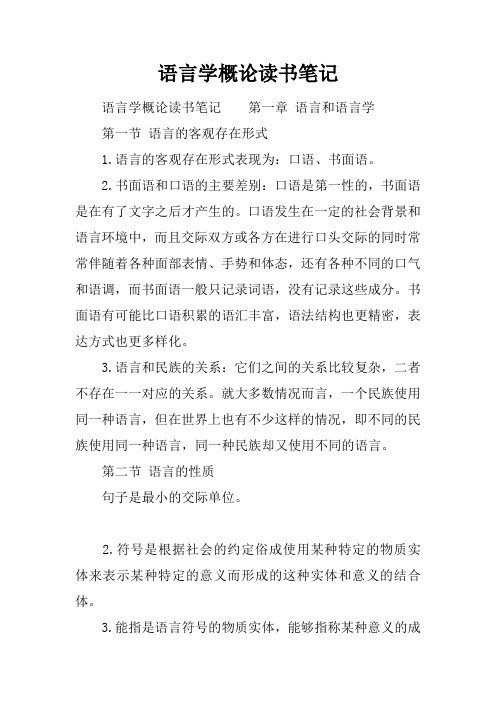
语言学概论读书笔记语言学概论读书笔记第一章语言和语言学第一节语言的客观存在形式1.语言的客观存在形式表现为:口语、书面语。
2.书面语和口语的主要差别:口语是第一性的,书面语是在有了文字之后才产生的。
口语发生在一定的社会背景和语言环境中,而且交际双方或各方在进行口头交际的同时常常伴随着各种面部表情、手势和体态,还有各种不同的口气和语调,而书面语一般只记录词语,没有记录这些成分。
书面语有可能比口语积累的语汇丰富,语法结构也更精密,表达方式也更多样化。
3.语言和民族的关系:它们之间的关系比较复杂,二者不存在一一对应的关系。
就大多数情况而言,一个民族使用同一种语言,但在世界上也有不少这样的情况,即不同的民族使用同一种语言,同一种民族却又使用不同的语言。
第二节语言的性质句子是最小的交际单位。
2.符号是根据社会的约定俗成使用某种特定的物质实体来表示某种特定的意义而形成的这种实体和意义的结合体。
3.能指是语言符号的物质实体,能够指称某种意义的成分。
4.所指是语言符号所指的意义内容。
5.组合关系是一个语言单位和前一个或后一个语言单位,或和前后两个语言单位之间的关系叫组合关系,也叫“句段关系”。
它体现在互相关联的语言单位组成的整体中。
6.聚合关系是在同一位置上可以互相替换出现的各个语言单位之间的关系。
7.语言与言语的区别:语言是使一个人能够理解和被他人理解的全部语言习惯,是社会成员约定俗成共同使用的部分,是均质的,是言语活动的社会部分;言语则具有个人特色,因为每个人说话的嗓音,每个音的具体发音,使用的词语和句子结构都不尽相同。
即语言是言语活动中同一社会群体共同掌握的,有规律可循而又成系统的那一部分;而含有个人要素或个人杂质的说话行为和说出来的话(包括写出来的“话”)只能属于言语。
8.语言符号的特征:任意性、强制性与可变性。
人们最初创制单个的语言符号时,用什么样的形式——语音与什么样的内容——语义相结合,并没有什么必然性,而带有很大的偶然性或随意性。
《语言学纲要》期末笔记
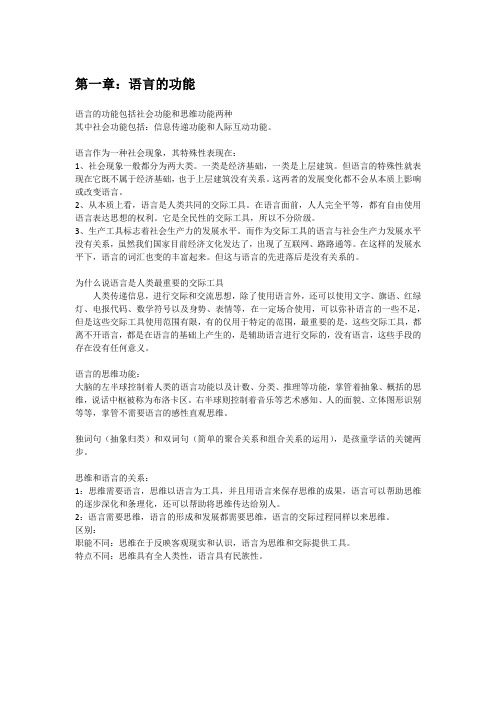
第一章:语言的功能语言的功能包括社会功能和思维功能两种其中社会功能包括:信息传递功能和人际互动功能。
语言作为一种社会现象,其特殊性表现在:1、社会现象一般都分为两大类。
一类是经济基础,一类是上层建筑。
但语言的特殊性就表现在它既不属于经济基础,也于上层建筑没有关系。
这两者的发展变化都不会从本质上影响或改变语言。
2、从本质上看,语言是人类共同的交际工具。
在语言面前,人人完全平等,都有自由使用语言表达思想的权利。
它是全民性的交际工具,所以不分阶级。
3、生产工具标志着社会生产力的发展水平。
而作为交际工具的语言与社会生产力发展水平没有关系,虽然我们国家目前经济文化发达了,出现了互联网、路路通等。
在这样的发展水平下,语言的词汇也变的丰富起来。
但这与语言的先进落后是没有关系的。
为什么说语言是人类最重要的交际工具人类传递信息,进行交际和交流思想,除了使用语言外,还可以使用文字、旗语、红绿灯、电报代码、数学符号以及身势、表情等,在一定场合使用,可以弥补语言的一些不足,但是这些交际工具使用范围有限,有的仅用于特定的范围,最重要的是,这些交际工具,都离不开语言,都是在语言的基础上产生的,是辅助语言进行交际的,没有语言,这些手段的存在没有任何意义。
语言的思维功能:大脑的左半球控制着人类的语言功能以及计数、分类、推理等功能,掌管着抽象、概括的思维,说话中枢被称为布洛卡区。
右半球则控制着音乐等艺术感知、人的面貌、立体图形识别等等,掌管不需要语言的感性直观思维。
独词句(抽象归类)和双词句(简单的聚合关系和组合关系的运用),是孩童学话的关键两步。
思维和语言的关系:1:思维需要语言,思维以语言为工具,并且用语言来保存思维的成果,语言可以帮助思维的逐步深化和条理化,还可以帮助将思维传达给别人。
2:语言需要思维,语言的形成和发展都需要思维,语言的交际过程同样以来思维。
区别:职能不同:思维在于反映客观现实和认识,语言为思维和交际提供工具。
- 1、下载文档前请自行甄别文档内容的完整性,平台不提供额外的编辑、内容补充、找答案等附加服务。
- 2、"仅部分预览"的文档,不可在线预览部分如存在完整性等问题,可反馈申请退款(可完整预览的文档不适用该条件!)。
- 3、如文档侵犯您的权益,请联系客服反馈,我们会尽快为您处理(人工客服工作时间:9:00-18:30)。
I. INTRODUCTION1.1 What is linguistics?1.1.1DefinitionLinguistics is the scientific study of language. It studies not any particular language, but it studies languages in general.1.1.2 The scope of linguisticsGeneral linguistics: This deals with the basic concepts, theories, descriptions, models and methods applicable in any linguistic study, in contrast to those branches of study which relate linguistics to the research of other areas.Branches of linguistics:phonetics phonology morphology syntax semantics pragmatics Linguisticspsycholinguistics sociolinguistics applied linguistics1.1.3 Some important distinction in linguistics1) Prescriptive and descriptiveThey are two different types of linguistic study. If a linguistic study aims to describe and analyze the language people actually use, it is said to be descriptive; if the linguistic study aims to lay down rules for “ correct and standard” behavior in using language, i. e. to tell people what they should say and what they should not say, it is said to be prescriptive.Modern linguistics is mostly descriptive.2) Synchronic and diachronicLanguage exists in time and changes through time. The description of a language at some point of time in history is a synchronic study; the description of a language as it changes through time is a diachronic study. A diachronic study of language is historical study; it studies the historical development of language over a period of time.In modern linguistics, a synchronic approach seems to enjoy priority over a diachronic one.3) Speech and writingThey are the two major media of linguistic communication. Speech is prior to writingfor the following reasons:From the point of view of linguistic evolution, writing system os any language is always "invented" by its users to record speech when the need arises.Then in everyday communication, speech plays a greater role than writing in terms of the amount of information conveyedSpeech is always the way in which every native speaker acquires his mother tongue and writing is learned and taught later when he goes to school.4) Langue and paroleThe distinction between langue and parole was made by the Swiss linguist F. de Saussure in the early 20th century.Langue refers to the abstract linguistic system shared by all the members of a speech community, and parole refers to the realization of langue in actual use.Langue is the set of conventions and rules which language users all have to abide by, and parole is the concrete use of he conventions and the application of the rules. Langue is abstract; it is not the language people actually. Parole is concrete; it refers to the naturally occurring language events. Langue is relatively stable; it does not change frequently; while parole varies from person to person, and from situation to situation.5) Competence and performanceThe distinction between competence and performance was proposed by the American linguist N. Chomsky in the late 1950’s. Chomsky defines competence as the ideal user’s knowledge of the rules of his language, and performance the actual realization of this knowledge in linguistic communication.6) Traditional grammar and modern linguisticsThe beginning of modern linguistics was marked by the publication of F. de Saussure's book "Course in General Linguistics" in the early 20th century.a) Linguistics is descriptive, while traditional grammar is prescriptive.A linguistist is interested in what is said, not in what he thinks ought to be said. He describes language in all its aspects, but does not prescribe rules of "correctness".b) Modern linguistics regards the spoken language as primary, not the written. Traditional grammar tended to emphasize the importance of the written word.c) Modern linguistics does not force language into a Latin-based framework. However, for a long time traditional grammar assumed that Latin provides a universal framework into which all languages fit.1.2 What is language1.2.1 Definition of language?Language is a system of arbitrary vocal symbols used for human communication. First, language is a system, i.e., elements of language are combined according to rules.Second, language is arbitrary in the sense that there is no intrinsic connection between a linguistic symbol and what the symbol stands for.Third, language is vocal because the primary medium for all languages is sound.The term "human" in the definition is meant to specify that language is human-specific, i.e., it is very different from the communication systems other forms of life possess, such as bird songs and bee dances.2.2 Design featuresDesign features refer to the defining properties of human language that distinguish it from any animal system of communication. The framework was proposed by an American linguist, Charles Hockett.1) ArbitrarinessLanguage is arbitrary because there is no logical connection between meanings and sounds. However, we should be aware that while language is arbitrary by nature, it is not entire arbitrary; certain words are motivated.2) ProductivityLanguage is productive in that it makes possible the construction and interpretation of new signals by its users. This is the way they can produce and understand an indefinitely large number of sentences in our native languages, including sentences that we have never heard before.3) DualityLanguage is a system, which consists of two sets of structures, or two levels. At the lower or the basic level there is a structure of sounds, which are meaningless by themselves. But the sounds of language can be grouped and regrouped into a large number of units of meaning, which are found at the higher level of the system.Then the units at the higher level can be arranged and rearranged into an infinite number of sentences.4) DisplacementHuman language can be used to refer to things which are present or not present, real or imagined matters in the past, present, or future, or in far-away places. In other words, language can be used to refer to contexts removed from the immediate situations of the speaker.5) Cultural transmissionThe details of the linguistic system must be learned anew by each speaker. Though the capacity for language in human beings has a genetic basis, the particular language a human being learns is a cultural fact, not a genetic one.1.2.3 Functions of language1. Language is used for communication2. Three main functionsA)Descriptive function(cognitive, referential, or propositional function)--- it is assumed to be the primary function of language. It is the function to convey factual information, which can be asserted or denied, and in some cases even verified.B)Expressive function(emotive or attitudinal function) --- supplies information about the user's feelings, preferences, prejudices and values.C)Social function, also referred to as interpersonal function, serves to establish and maintain social relation between people.3.Function models by structural linguist Roman JakobsonHe identifies six elements of a speech event and relates each one of them to one specific language function.Addresser--- EmotiveThe addresser expresses his attitude to the topic or situation of communication. Addressee--- ConativeThe addresser aims to influence the addressee's course of action or ways of thinking. Context --- ReferentialThe addresser conveys a message or information.Message --- PoeticThe addresser uses language for the sole purpose of displaying the beauty of language itself.Contact --- Phatic communicationThe addresser tries to establish or maintain good interpersonal relationship with the addressee.Code --- MetalinguisticThe addresser uses language to make clear the meaning of language itself.4.Three macrofunctions by M. A. K. HallidayIn the early 1970s the British linguist Halliday found that child language performed seven basic functions and there is close correspondence language between form and function. But as a child grew into an adult the seven functions are gradually replaced by a more abstract, but also simpler system of functions. This system contains three macrofunctions.Ideational function is to organize the speaker or writer's experience of the real or imaginary world. It corresponds closely to the descriptive function discussed above, but it is broader because it also includes the expression of the speaker's attitude, evalution, his feelings and emotions.The interpersonal function is to indicate, establish, or maintain social relationships between people. It expresses the speaker's role in the speech situation, his personal commitment and assessment of the social relationship between the addressee and himself.The textual function is to organize written or spoken texts in such a manner that they are coherent within themselves and fit the particular situation in which they are used.。
